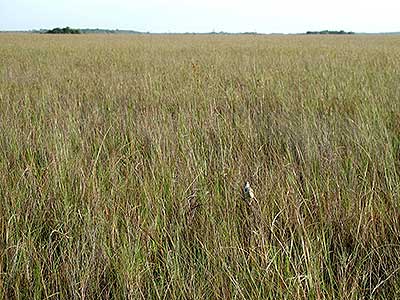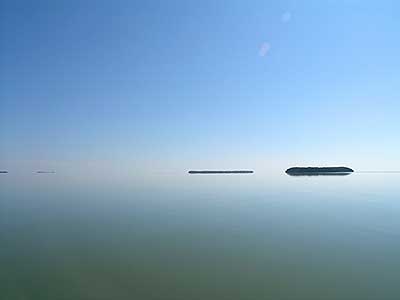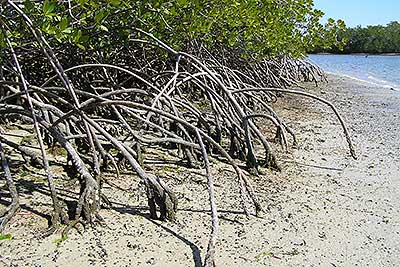
Saltwater intrusion threatens Florida parks
Climate change, pollution, rising sea levels and the warming of the oceans have been in the news for quite some time now. And yet it is a threat that seems distant and abstract, a phenomenon that the general public is aware of, but can’t really quantify. Something that doesn’t hit home until it actually does.
Well, now it has.
South Florida’s national parks are under duress and the stakes are higher than ever.
“The parks are affected in a number of ways with climate change,” said Don Finefrock, executive director of the South Florida National Parks Trust in Coral Gables. “That includes warming ocean temperatures and the acidification of the oceans [which] affects coral reefs. And of course some of the most spectacular parts of Dry Tortugas and Biscayne National Park are the coral reefs.”
| Click on the video at the right to view an audio slideshow about rising ocean levels in South Florida prepared and narrated by writer Patrick Riley. Graphics were provided by Harold Wanless, University of Miami. |
But the coral reefs aren’t the only parts of the parks that are affected.
“Florida Bay is about half a million acres and where the water meets the land is this incredibly productive estuary and marine lagoon where that mix of salt- and freshwater creates ideal conditions for a number of species to breed and spawn,” Finefrock explained. “And so it’s an incredibly productive fishery and ecosystem.”
But according to Finefrock, as the sea level rises and storms become more frequent, the interior lagoon on Cape Sable, which is located at the southern tip of Everglades National Park, becomes inundated.
“It used to be a freshwater marsh back there, it’s now a saltwater lagoon,” Finefrock said. “So it’s changed and you find that as saltwater intrudes, sea levels rise, saltwater intrudes northward into the Everglades, you see that the mangroves are moving north.”
| Freshwater prairies are a vital part of Everglades National Park’s ecosystem and could soon be compromised due to saltwater intrusion and sea level rise (Photo courtesy of the National Park Service). |  |
Dr. Harold Wanless, geology professor and chair of the department of geological sciences at the University of Miami, has taken Finefrock on excursions to said cape. He knows what kind of problem the so-called white zone on the north shore of Florida Bay presents to the vegetation there.
“It’s all along the north shore of Florida Bay and that is the zone that in the wet season tends to be freshwater and in the dry season tends to become very salty,” Wanless explained. “And that’s expanded landward and broadened. There’s a zone of fluctuating salinity that is a real challenge for plants to live in, because most of them are either happy in the saltwater or happy in the freshwater, but not with the fluctuations. And when they dry out, the area can get really salty. It’s not just like ocean water, it can get really salty. So it’s certainly not an easy place to live.”
According to a status and trends report put forth by the South Florida Natural Resources Center titled “Salinity and Hydrology of Florida Bay,” there has been an overall increase in salinity in the eastern and central zones of Florida Bay and recurrent high salinity in the Taylor River. The study further states “salinity in these estuarine zones is, on average, rising and approaching marine conditions for most of the year.”
The more saline water conditions then trigger a domino effect that continues all the way up the food chain, as John Adornato, Sun Coast region director of the National Parks Conservation Association explained:
 |
Parts of Florida Bay have seen an increase in salinity over the years with some areas even approaching marine conditions or worse (Photo courtesy of the National Park Service). |
“So, the freshwater would come into Florida Bay and make it less saline which provided a healthier sea grass bed which provided for a lot of refuge for the crustaceans and the lower level food chain for some of the recreationally and commercially important fish species. So there would be shrimp and these healthy shrimp populations would lead all the way up the chain to snook and tarpon, red fish, etc. And with these hyper-saline conditions the sea grass beds are more impaired and therefore don’t provide as good a habitat for that food chain.”
This does, however, not mark the first time human interference has caused trouble for South Floridian wildlife.
After the hurricanes of 1947 and 1948, many low-lying areas in Miami were flooded which prompted the authorities to search for a solution to protect the affected areas in the future.
“They made a decision,” Wanless said. “It wasn’t an evil one, but between 1960, when this dike system that we call South Florida water management system went into effect, and 1992, the bird population in Everglades Park decreased by 90 percent, because the timing of the water delivery was wrong for the reproductive needs of the birds and the babies. […] An absolute disaster.”
The water schedule has since been adjusted to reverse some of the damage, but new threats to the park and the environment at large are already on the horizon.
“I think Everglades National Park has been on life support for a long time,” Finefrock said. “Not because of sea level rise or saltwater intrusion, but because of the lack of freshwater being delivered into the park from the north.”
The lack of freshwater could lead to drastic changes in both vegetation and wildlife. One main culprit for this concerning trend is Tamiami Trail.
“It was the first roadway to cross the state in South Florida, before Alligator Alley was built,” Finefrock said. “It opened up the interior of the Everglades and it created a route across to Naples. But it also created a barrier, a dam if you will, for water that would’ve flowed south. The natural course of the Everglades is [the] water is going out of Lake Okeechobee into what is now agricultural lands, […] and moving south in one broad great river of grass to the southwest and toward Florida Bay.”
But now this water flow has been effectively barred from moving south since the 1920s. Fortunately, measures have been taken to counter this decade-old problem.
“What they’ve done now is they built a one-mile bridge where they lifted the roadway to allow water to flow under the bridge,” Finefrock said. “They removed the old roadbed and so water is now flowing into Everglades National Park in greater quantities than it did just a few years ago.”
But while the aforementioned bridge project was initiated more than 20 years ago and still is not fully completed, Adornato is optimistic that a large number of similar projects that are in the works or already off the ground will eventually restore the Everglades (and with it its national parks) to its natural state.
“I am very optimistic about the prospect of seeing these projects come to fruition,” Adornato said. “The statistic is that one in every three Floridians gets their water from the Everglades. […] There has been a lot of money spent by communities along the coast in South Florida to move their water supply pump inland, because of saltwater intrusion. Well, Everglades restoration will help abate that saltwater intrusion. And therefore we need to make sure that these projects happen so that we don’t have these ever-increasing salinity problems.”
Others, like Wanless, are less optimistic.
| As sea levels rise and saltwater intrudes into the Everglades, mangroves move more and more inland, thereby slowly changing the natural landscape (Photo courtesy of the National Park Service). |  |
“If sea level rises a foot and if we can’t raise all that a foot then we’re going to have saltwater intrusion and certainly by the time we have a two-foot rise of sea level, but probably before, we will have lost our ability to keep the seawater out, unless we start abandoning communities,” Wanless explained.
But even before houses will be underwater, we may be unable to insure them.
“We have to do something, because all of a sudden insurers aren’t going to insure our homes,” Wanless said. “And that’s coming very quickly.”
Wanless, who has held numerous talks on the subject in recent years, does not think that much will change though. He believes that the people chairing the commissions and sitting at the roundtables will simply lowball the projections.
“Everybody is trying to pretend that this isn’t that important,” Wanless said. “People are talking about it now. I don’t have people throwing eggs at me when I talk about it anymore, but nobody is doing anything.”
Sadly, as is the case so very often in life, the ones who are at least at fault may end up paying the highest price. The flora and fauna of South Florida may soon be forever lost, engulfed and swallowed up by the ever-rising sea.
And with it Everglades National Park.
“It’s going to turn into an estuary,” Wanless said.
What are saltwater intrusion and sea level rise? How will they affect us?
- “At the coast there is a boundary between the freshwater which is less dense than seawater and the saltwater,” Wanless said. “You can think of the freshwater as being a layer on top of the saltwater. As you go inland it’s floating on saltwater and even in the middle of the state if you drill down, you’ll find saltwater somewhere down there.”
- According to Wanless, the only way to “prevent surface saltwater intrusion is to maintain the freshwater a foot or a foot and a half above saltwater level.” An option, however, that becomes increasingly unrealistic with the acceleration of sea level rise.
- Wanless said that we may be at plus two feet (60 centimeters) of sea level rise by as early as 2048. According to the South Florida water management district an eight inch (20 centimeters) rise of sea level will render 65 percent of the water control structures, such as dams, dikes and canals, useless. “With a 50 centimeter rise of sea level, that’s a foot and two-thirds, over 80 percent of the structures will no longer work,” Wanless said. “What I mean by that is that if they try to keep the freshwater a foot or a foot and a half above the rising sea level, they will start to flood out communities.” Cities like Hialeah, Sweetwater, and other ones in the western part of Miami-Dade and Broward County would all be underwater.
- One of the main problems is the fact that much of South Florida rests on very porous limestone, which allows for water to pass through rather quickly. Furthermore, the peat, which is the organic soil like roots and root materials, has slowly oxidized away ever since it has been exposed due to the draining of the Everglades. “We can hold back the sea and the Everglades for the next couple feet if we can rebuild the organic peat in the Everglades,” Wanless said. “There are areas out here that there used to be seven or eight feet of organic peat. […] But what that organic soil – peat – is, is a sponge. […] It’s like a huge sponge and during the dry season it holds water like a sponge would below the surface.” Unfortunately, biologists say that the peat can only be built back at a rate of about a foot per century, which won’t be fast enough according to Wanless: “That’s going to be too slow if we’re at four feet at the end of the century. We’ll have turned the Everglades into a water wonderland.”
- Interestingly enough, sea level rise will affect us as much from the backside (the Everglades) as it will from the front (the ocean), because Miami is situated on a coastal ridge. This means that low-lying areas such as Broward County would be flooded while much of Miami would essentially turn into island structures not unlike the Keys.
- According to Wanless, most studies suggest that sea level rise by the end of the century will be between four and six feet. A problem that will then snowball, said Wanless, because the ocean will then rise at about a foot per decade.

Comments are Closed